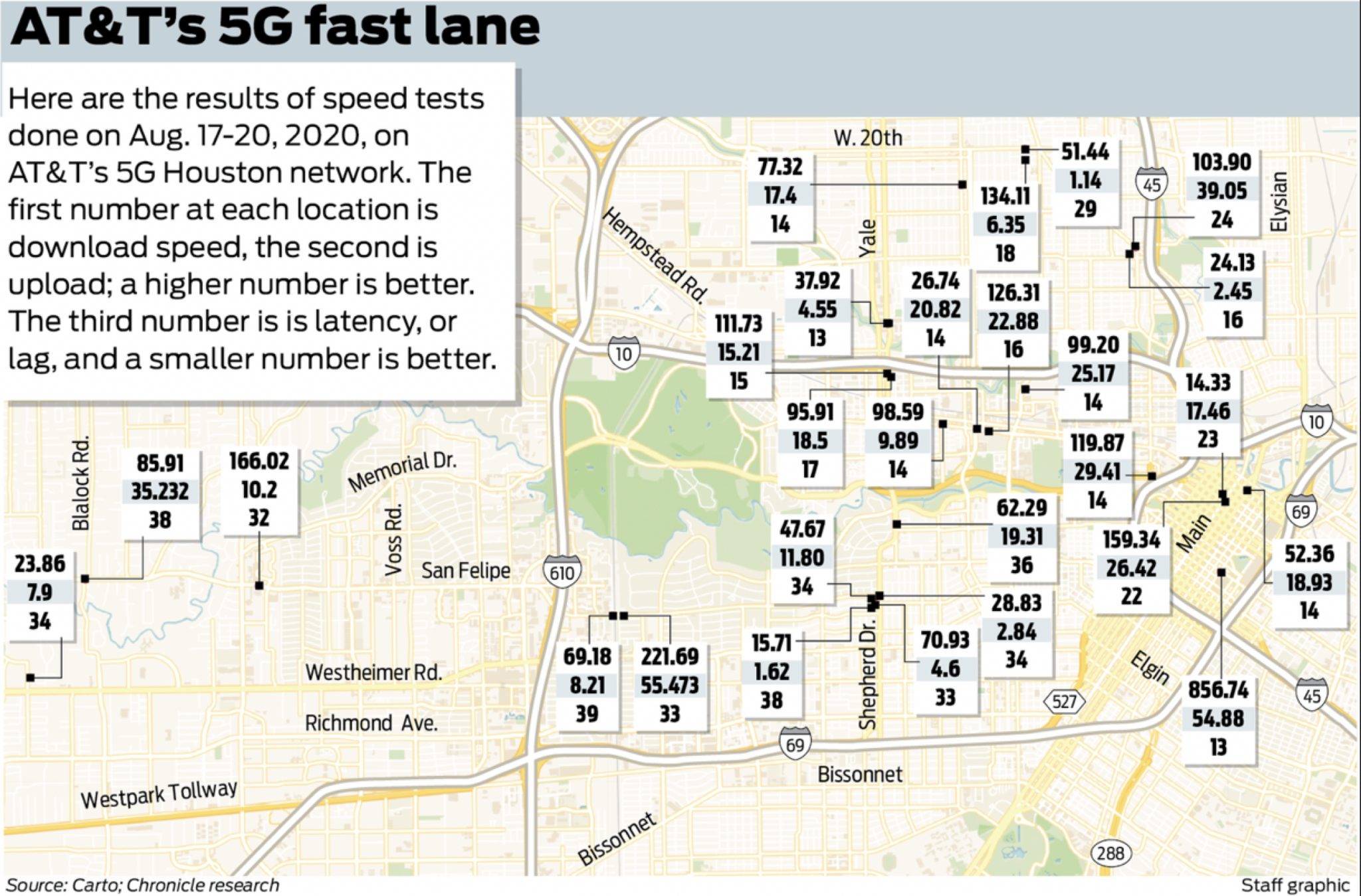
If you’re an AT&T customer who’s craving 5G wireless data service that rivals the fastest home internet speeds, I’ve got some good news for you: It’s here in Houston.
And by “here” I mean in a few spots downtown. You’ll have to look to find them, and you’re best off if your search is on foot, because the signal can’t penetrate the metal and glass of most vehicles.
Instead, what you’ll mostly encounter is a tamer form of 5G that’s a solid improvement over LTE, but not the jaw-dropping speed that 5G hype has led many to expect.
Last month, AT&T launched a 5G mobile network that combines both the more common, so-called sub-6 spectrum and the astonishingly fast millimeter wave variety. Sub-6 is also used by T-Mobile.
REVIEW: T-Mobile's 5G feels a lot like 4G
AT&T was last to the 5G party here, beaten to the punch in Houston by Verizon and T-Mobile. Sprint was actually the first to stand up a local 5G network, which worked on middle frequencies between sub-6 and millimeter waves. Sprint has since merged with T-Mobile, which is working to integrate the two systems.
I tested AT&T’s network last week with a loaned Samsung Galaxy S20 5G phone running the popular Speedtest app from Ookla. I drove routes from the center of town out to the west and near northern suburbs. At best, I’d describe the results as inconsistent, but when AT&T’s network was working well, it was impressive. Sometimes, I even said “wow!”
First, some technical background.
The hype around 5G centers on promised faster connections than the older, 4G LTE wireless standard. Those speeds, combined with a shorter delay between asking a network for information and getting a response - known as latency - are touted as enabling all kinds of new applications, ranging from advanced telemedicine to self-driving vehicles to wireless competition for home broadband providers.
So far, it’s mostly just that: hype. Both AT&T and T-Mobile concede their sub-6 5G is an incremental improvement over 4G for now. And AT&T says its faster, millimeter wave service is primarily for use where people gather, such as in parks, on college campuses and in large sporting or concert venues. (Verizon, which for now only has a millimeter wave network, echoes AT&T’s use cases.) That’s because millimeter wave can’t pass through buildings or even foliage, and requires a dense collection of antennas known as small cells.
5G FUTURE: Houston's 5G landscape is complete. Now what?
In testing AT&T’s sub-6 5G network, which is available across most of Houston, I saw download speeds as low as 14 Mbps and as high as 222 Mbps, with an average of 70 Mbps. For comparison, PC Mag, which conducts annual tests of mobile networks around the country, clocked AT&T’s average LTE downloads in Houston in 2019 at 42 Mbps, with a maximum of 173 Mbps.
When I say “inconsistent,” here’s what I mean: In one spot on the north side, I got a 51 Mbps download result and a minute later, 8 Mbps. That was not uncommon, but it’s also not uncommon with LTE.
Sub-6 upload speeds weren’t great, ranging from 1.1 Mbps to 39 Mbps, with an average of 14 Mbps. Most early 5G networks use 4G for uploads, and that’s the case with AT&T, though 5G is also utilized.
AT&T’s millimeter wave network, which it markets as 5G+, was much more impressive. The slowest download speed I got was 90 Mbps and the maximum was 857 Mbps. This was in one spot in downtown Houston — standing on the plaza outside Toyota Center, where the average download speed was 373 Mbps.
Release Notes: Get Dwight Silverman’s weekly tech newsletter in your inbox
Upload speeds ranged from 51 Mbps to 60 Mbps, with an average of 55 Mbps.
But finding this location required help from an AT&T spokesperson. On the evening I did the other driving tests, I cruised around the Discovery Green area, where I’d initially been told 5G+ was available, and only got standard 5G. I had even driven past the Toyota Center and didn’t pick up the faster network.
It’s important to keep in mind that these are early days for 5G. If you buy a 5G phone now on AT&T’s network — or its competitors’, for that matter — you’re likely to see improvements and greater consistency over time. But for now, those who snatch up a 5G phone are early adopters. Don’t expect to be blown away just yet.
dwight.silverman@chron.com
twitter.com/dsilverman
houstonchronicle.com/techburger
"network" - Google News
August 24, 2020 at 07:00PM
https://ift.tt/2Ql2E3X
AT&T’s 5G network is inconsistent, but shows promise - Houston Chronicle
"network" - Google News
https://ift.tt/2v9ojEM
https://ift.tt/2KVQLik
Bagikan Berita Ini














You have performed a great job on this article. It’s very precise and highly qualitative. You have even managed to make it readable and easy to read. You have some real writing talent. Thank you so much. Houston party characters
ReplyDelete